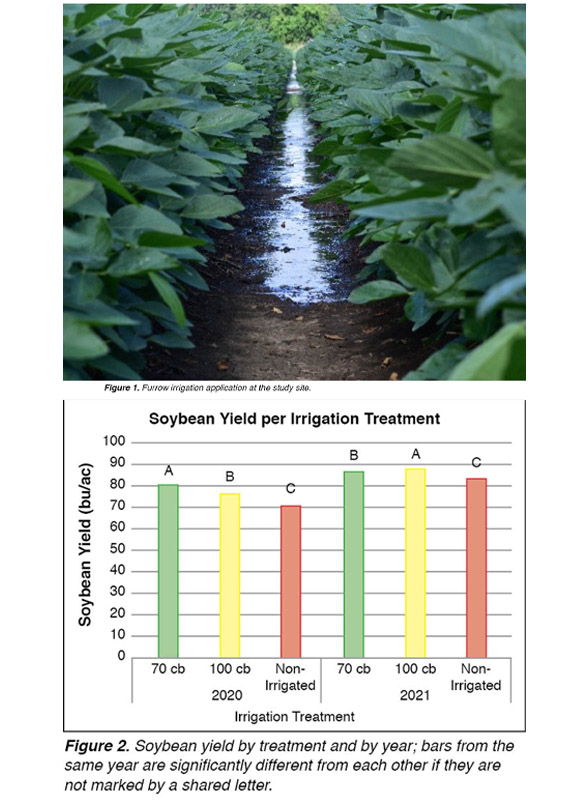Research Project
Revisiting Recommendations for Sensor-Based Soybean Furrow Irrigation Scheduling on Clay Soils
Investigators: Jacob Rix, Himmy Lo, Lyle Pringle
Date: 2021
Project Summary
Introduction
In the Mississippi Delta, irrigated soybean on clay soils is very common. Appropriate irrigation scheduling recommendations for this crop and soil combination are thus especially important because these recommendations would be useful on many acres. Over the past decade, MSU on-station and on-farm research on irrigation scheduling has focused on the use of Watermark soil moisture sensors. The findings of those experiments led to MSU Extension recommendations that soybean on clay soils should be irrigated whenever the average sensor value across the soil profile reaches somewhere between 70 and 100 centibars. To generate additional data on the effect of triggering irrigation at different centibars, a study was performed in Stoneville, MS, from 2020 to 2021.
Materials and Methods
The experiment was conducted on a 20- acre field whose Sharkey clay soil tends to shrink and form cracks as it dries and to swell and seal up as it wets. Planting and harvest dates were 5/7 and 10/5 in 2020 and were 4/19 and 10/1 in 2021. For both years, Asgrow 48X9 soybean seed was planted in twin rows on raised beds with 40” spacing. Within a month of emergence, a Watermark soil moisture sensor set was installed two thirds the way down each plot between an interior pair of twin rows. Furrow irrigation was applied using polypipe (Figure 1). The harvest area per plot was 20 feet (6 rows) wide by 530 feet long. Yield values were adjusted to a standard moisture of 13%. The three treatments included: (1) irrigation triggered at 70 centibars, (2) irrigation triggered at 100 centibars, and (3) no irrigation. The 70 centibar treatment was irrigated five times in 2020 and six times in 2021. The 100 centibar treatment was irrigated two times in 2020 and three times in 2021. The non-irrigated treatment was never irrigated in both years. For statistical analysis, Fisher’s Least Significant Difference test was used in SAS software
Results and Discussion
Triggering at 100 centibars rather than 70 centibars delayed irrigation by approximately four days per drying cycle. This extra time to catch rain eliminated three irrigation applications per year and reduced groundwater pumping by about 30%. Agronomically and financially, the best treatment varied between years (Figure 2). In 2020, when consecutive weeks without rain were common, the 70 centibar treatment achieved the highest yield and return. Yet in 2021, when small rains that did not reach the Watermark soil moisture sensors were common, the 100 centibar treatment achieved the highest yield and return. This observation agrees with past research showing that excessive irrigation can decrease soybean productivity and profitability. On farms that require three to five days to irrigate all their soybean on clay soils, we confirm existing MSU Extension recommendations that a furrow irrigation cycle should be started when the first irrigation set dries to roughly 70 centibars. This practice minimizes both the risk of over irrigating the earlier sets and the risk of under irrigating the later sets. By following these locally proven recommendations, farmers can conserve the precious groundwater resources of the Delta while maximizing their likelihood of producing a profitable and high-yielding soybean crop.
Project Photos

- Topic:
- Irrigation Scheduling
- Irrigation
Find Research
By Crop Type
By Topic
Contact NCAAR
General Information
Kaye Sullivan
vfs23@msstate.edu
662.390.8510
F:662.390.8501
Showcase Demo
Drew Gholson, Coordinator
drew.gholson@msstate.edu
662.390.8505
Himmy Lo
himmy.lo@msstate.edu
662.390.8509

